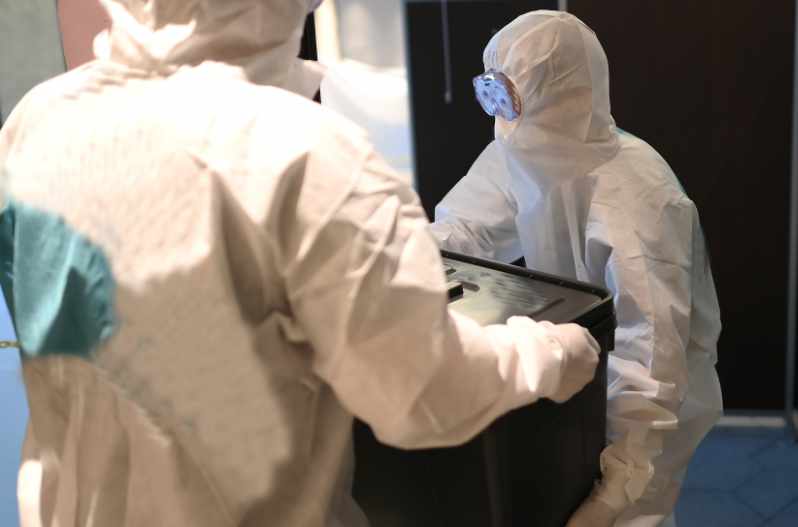Biological contaminants can provide important evidence in a wide range of criminal investigations, from violent crimes to property crimes. From blood and semen to saliva and skin cells, these contaminants can provide valuable DNA evidence that can help identify suspects and link them to a crime. However, they can also spread bloodborne diseases. If you come into contact with any of these biological contaminants, you can get infected. Outside of biological materials, drugs and drug residue also pose a significant health risk. Here are the most common biological crime scene contaminants and what you need to do to keep yourself safe.
What Are the Main Biohazard You Can Find at a Crime Scene?
While blood is often the biggest risk, there are a number of potential biohazards at any crime scene. Here are the main biological contaminants to watch out for:
- Blood: Blood leaves behind on a wide range of surfaces, including walls, floors, furniture, and clothing. This makes it one of the most common biohazards found at a crime scene. While it can provide important DNA evidence, it can also spread HIV and hepatitis B and C viruses.
- Semen: Commonly associated with sexual assault cases, semen can spread nearly all bloodborne diseases. While it usually has a white or yellowish color, it can easily get confused with other liquids.
- Tissue: Tissue includes pieces of skin or muscle and usually contains blood or other body fluids.
- Human or animal remains: Human or animal remains can contain a wide range of pathogens, including bacteria, viruses, and parasites.
- Drug residue: Drug-making chemicals are extremely hazardous. While some can intoxicate you, others are dangerous and can even cause death.
Any biological materials can contain viruses, bacteria, and other pathogens. If you are not careful, you can infect yourself or even cause serious illness or death. Avoid touching them and wait for qualified biohazard or crime scene cleanup before entering your home.
Other risks include chemicals and drug residues that can be extremely toxic. However, it’s important to note that this is not an exhaustive list. There are many other potential biohazards you could encounter at a crime scene. To protect our health and safety, always assume the area is contaminated with biohazards.
Also, you should never assume that a crime scene with biological contaminants is safe for any reason. Even if it’s your home, you cannot be sure it’s completely risk-free. The scene could include contaminations from the perpetrators of the crime. Friends and family members involved in the incident could also be unknowingly infected.
How To Cleanup Biological Contaminants at a Crime Scene
Cleaning up a crime scene that involves biological hazards is a complex and dangerous task. Call a qualified biohazard or crime scene cleanup company if you see any of the contaminants listed above. They have the training and equipment to quickly and safely restore your home.
Talk to a local pro now. Certified Restoration Local biohazard cleanup specialists offer 24-hour service and fast, free quotes.
Steps for Removing Biological Contaminants at Crime Scenes
Cleaning up a crime scene that involves biohazards involves these general steps:
- Assessing the scene: The first step is to assess the scene. Only a professional trained in biohazard cleanup should assess the scene. They will determine the extent of the contamination and the type of biohazards present.
- Securing the scene: To prevent further contamination and to protect those involved in the cleanup, secure the scene. This includes setting up barriers and using personal protective equipment (PPE) such as gloves, masks, and gowns.
- Removing contaminated materials: Then they will remove contaminated materials. These can include blood-soaked carpeting and furniture. They will properly bag contaminated items and dispose of them in accordance with state and local regulations.
- Cleaning and disinfecting the area: Thoroughly clean and disinfect the area, and remove any remaining biohazards and contaminated materials at this time. This may involve using specialized cleaning agents and equipment.
- Testing for remaining hazards: After cleaning and disinfecting the area, it should be tested for any remaining hazards.
- Removing Personal Protective Equipment (PPE): After completing the cleanup process, the workers should remove their PPE and properly dispose of it to prevent cross-contamination.
- Decontamination: Workers should decontaminate themselves and their equipment to prevent cross-contamination.
- Final Inspection: A final inspection of the scene should be conducted to ensure that the area is completely clean and safe for re-entry.
- Restoration: After biohazard cleanup is complete, it may be necessary to restore portions of the crime scene. Typically this includes repairing or replacing walls and installing new flooring.
Important Note About Crime Scene Cleanup
It’s important to note that these steps may vary slightly. The exact process depends on the specific circumstances of the crime scene and the type of biohazards present. Your biohazard and crime scene cleanup company will review the specific process based on your damage and circumstances.
Don’t let a traumatic event leave a lasting impact on your home. Call Restoration Local today for discreet and professional biohazard cleanup services. Our local contractors are available 24/7 to provide you with a free quote and compassionate service. Put your trust in us to restore your home quickly and efficiently. Give us a call at 1-888-790-7879 now. At Restoration Local, we handle the cleanup so you can focus on healing and moving forward.





